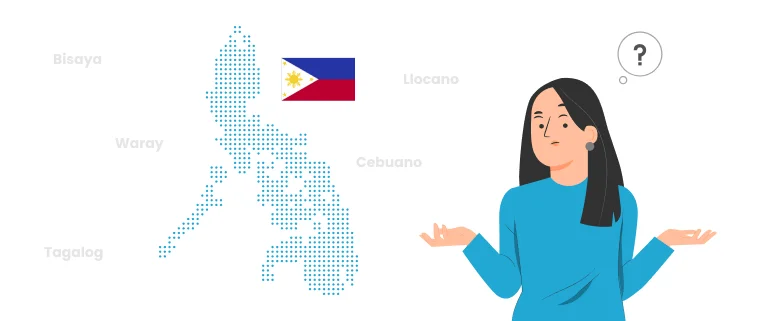The Philippines, also known as the “Pearl of the Orient Seas” in Asia, is a culturally diverse country with over 170 existing languages and dialects. The Philippines is home to more than 7000 islands, old churches, forts, and ancient museums, earning the country the label of Asia’s Pearl of the Orient. This phrase refers to a pearl that has formed naturally without any human interference. This beautiful piece of land has a rich background, cultural diversity, and eight major languages that have great influence globally.
This insightful blog talks about the history of languages in the Philippines and the main languages that the majority of the population speaks. Also, the evolution of cultural and historical background will be a part of our discussion. We will also give you an overview of how many dialects does the Philippines have. We will give you information about the six most popular dialects in the country.
Table of Content
Language vs Dialect vs Accent
Almost everyone knows the difference between these terms, but a quick sneak peek before delving into the topic can be helpful.
Language is a combination of words and the system we apply to these words such as grammar and spelling to ensure flawless communication. It includes the spoken, written, and signed forms of words.
Dialect is a version of each language with the same features but differences in vocabulary, grammar, and use of each term. A language can have multiple dialects that may vary because of region or culture. For instance, English is a common language but it has different dialects, Standard American English and British English.
Accent refers to the way people speak a language. Each word can have a different pronunciation based on location, area, or audience.
History of Languages in the Philippines
The Philippines is home to many famous languages. From Tagalog to modern-day Filipino, the journey of language evolution in the Philippines is filled with historical stories. Back in the 1500s, when the Spanish entered the Philippines, they noticed the dominance of three major languages in the region Tagalog, Llocano, and Visayan. Even though all these languages are different, the Philippines were able to interact and communicate in at least two of them.
Tagalog had a huge volume of speakers. Spanish-speaking people never identified the need to replace common languages but their language garnered huge popularity over the years. However, the Philippines came under the Spanish colonial administration in 1565, pursuing them to make Spanish their official language. The administration ruled the area for the next 300 years but the 1935 Constitution identified English as another official language while reinstating the status of the Spanish language. In 1987, the state put down the Spanish language as an optional or voluntary language. This minimized the dominance of the Spanish language after decades of American influence. After Spanish, the English language started gaining traction as the Philippines were voicing for a peaceful independence.
Tagalog became the official language of the Philippines alongside English in the early 20s. Tagalog was renamed to Pilipino to differentiate it from the Tagalog ethnicity and make it universally adoptable. Moreover, the 1973 constitution made further amendments to its name by replacing it with Filipino. It won’t be wrong to say that the modern-day Filipino is Tagalog with a different identity. Today, there are numerous languages and dialects in the Philippines. This diversity and expansion of the Philippines’ culture identifies a pressing demand for language competence.
Official Languages of the Philippines
The Philippines has two official languages with Filipino covering 87% and English representing only 3% of the entire population. It is because the roots of the region belong to Tagalog specifically. Moreover, the Philippines has eight major languages that are being spoken by a substantial portion and recognized as a mode of communication among different communities.
1. Filipino Language
Although we have had enough discussion on the Filipino language, its global extent and capability is undeniable. As the language has evolved, Filipino has numerous loanwords from Spanish, English, Malay, and some other languages. Filipino is known as a lingua franca across the Philippines. However, many other Filipinos still prefer their regional languages or dialects to keep them alive within the society. Furthermore, the language follows the Latin alphabet for writing and can also be written using Baybayin script. With time, the Baybayin script lost its popularity and the most common writing pattern is still the Latin alphabet. While the language represents a wider audience in the country, it is one of the leading Filipino dialects that is constantly enlarging.
2. English
Filipino is considered the native language by the majority of the population but English has sustained its position, all thanks to long-standing colonial administration. In the Philippines, English has a significant reputation as you can easily spot people communicating in English regularly. Not because the language has the perks of being official, but because it is the primary mode of communication for business, education, and other aspects of life.
English has a huge extent in the world of business and commerce. The same goes for the Philippines’ industries and business sectors.
In the last few decades, English has gained prominence, with almost 59% of native Filipinos now able to understand and communicate in it. Even in the local market, a person who is capable of interacting in both official languages has a certain edge over native Filipino speakers. Moreover, this competition is motivating Filipino speakers to become proficient in the English language as well as to thrive in their specific industry.
How Many Dialects in Philippines?
Estimates show there are around 120-187 languages spoken in the Philippines. When it comes to regional variations or dialects, these are about 111. However, in the scope of this blog, we’ll only cover the top 6 of them.
1. Tagalog
You will be surprised to see Tagalog here, as we just mentioned that the modern-day Filipino is the Tagalog language. Tagalog is a major dialect in the Philippines with over 34 million speakers. Tagalog is the official language of Singapore, Malaysia, Indonesia and Brunei. Having its own set of rules and standards, Tagalog is a major language.
2. Cebuano
Cebuano is a major language that has its community in specific areas of the Philippines. Visayas and Mindanao areas are home to the Cebuano language and its name comes from the island of Cebu. Cebuano accounts for one-fifth of the population of the Philippines. The language once had the largest native-language-speaking community in the country during the 1950s and 1980s. Cebuano is a literary language, newspapers, forums, and production houses also make use of Cebuano language.
3. Ilocano
Ilocano, a member of the Austronesian language family, is the third most-spoken language in the Philippines after Filipino and English. Over 7.7 million people natively speak Ilocano in different regions of the Philippines. You can find the majority of Ilocano speakers in the Ilocos Norte, Ilocos Sur, and La Union. The language settled in the Ilocos region when the Spanish arrived and started gaining popularity over time.
4. Tausug
Tausug is the native language of Tausug people residing in the Philippines, Malaysia, and other regions across the world. The language comes from the same Austronesian language family and the majority of its speakers belong to the Southwestern Philippines. Tausug is a dialect of Malay with a combination of Arabic and Spanish words as the land was highly influenced by Spanish people. Tausug has been there for centuries and the language has also survived different eras similar to the Tagalog language.
As most of the Tausug speakers migrated from neighboring Muslim countries, Indonesia and Malaysia, the language does not have any regional background from the Philippines. However, recent statistics show that its native speakers are decreasing with time as people are migrating or shifting towards other languages for trade and business relations.
5. Hiligaynon
Despite having no official identity in the Philippines, Hiligaynon has more than 9.1 million native speakers. Among the major Philippines dialects, Hiligaynon is the fourth largest ethnolinguistic group. The language came into being during the 16th century and has a great influence from the Spanish language. In addition to Spanish, the language has almost 30 to 50% words similar to Cebuano; however, speakers of both languages still face difficulty communicating natively.
6. Maranao
Maranao language speakers represent the largest Islamic community in the Philippines. The language is spoken by the people of Lake Lanao which is about 2200 feet above sea level. In addition to being the largest lake in Mindanao, Lake Lanao is the second-largest lake in the Philippines. Maranao is among the major languages in the Philippines and a mode of communication for Muslims living in these areas.
These eight major languages are widely adopted by the people of the Philippines. They have rich cultural and historical relevance with different regions of the country. Several factors have contributed to the survival and expansion of these languages not only in the Philippines but also globally. The global expansion of these languages identifies a pressing demand for learning more international languages. After diving deeper into this blog, you can be sure that you have gained detailed information about the historical and cultural background of this beautiful country which has more than 7000 islands. Hopefully, you found this article interesting and got to know about the evolution of these dialects.



